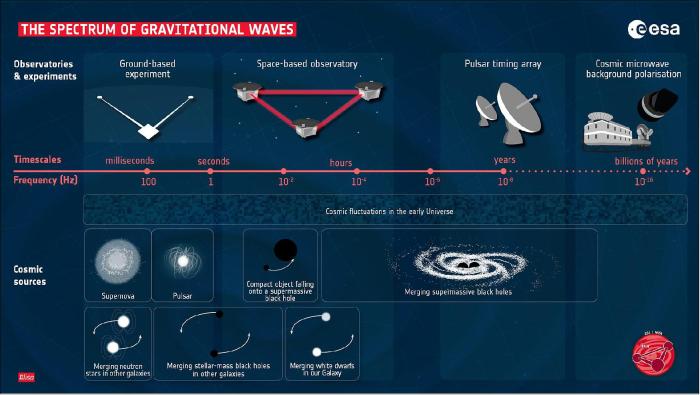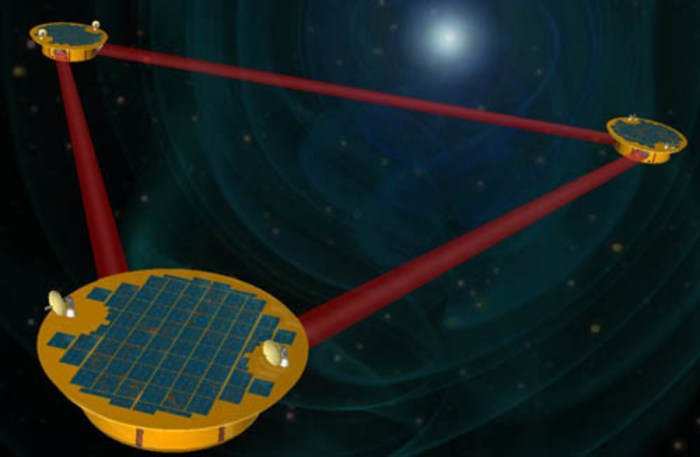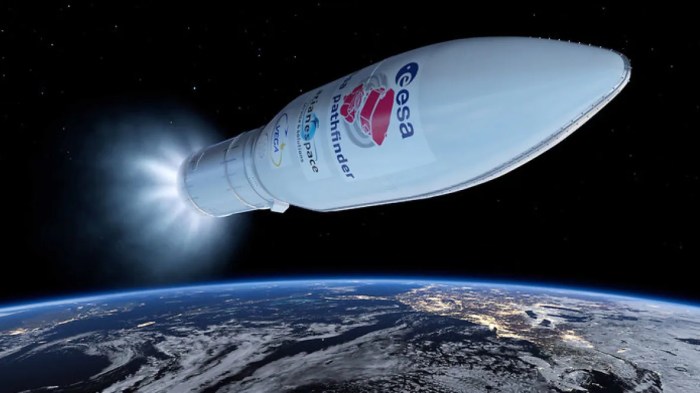Esa lisa mission gravitational waves ripples space tech – ESA’s Lisa mission, a groundbreaking endeavor to detect gravitational waves ripples in space, promises to revolutionize our understanding of the universe. This ambitious project, utilizing cutting-edge technology and a unique space-based interferometer, aims to capture the faint whispers of cosmic events that have long eluded our senses.
Imagine a symphony of gravity, a chorus of cosmic events, and a dance of black holes and neutron stars – all echoing through the fabric of spacetime. Gravitational waves, ripples in this fabric, are the messengers of these cosmic dramas, carrying information about the universe’s most extreme phenomena.
Lisa, a constellation of spacecraft orbiting the Sun, is poised to listen to this symphony, offering unprecedented insights into the universe’s secrets.
ESA’s Lisa Mission: Esa Lisa Mission Gravitational Waves Ripples Space Tech
The Laser Interferometer Space Antenna (LISA) is an ambitious space mission led by the European Space Agency (ESA) to detect gravitational waves from the most massive and energetic events in the Universe. This mission aims to revolutionize our understanding of gravity, black holes, and the evolution of the cosmos.
The Scientific Motivation for Detecting Gravitational Waves
Gravitational waves are ripples in the fabric of spacetime that propagate at the speed of light. They were predicted by Albert Einstein’s theory of general relativity in 1915. Einstein’s theory proposes that gravity is not a force but a manifestation of the curvature of spacetime caused by the presence of mass and energy.
Massive objects, like black holes and neutron stars, create disturbances in spacetime that propagate outward as gravitational waves.The detection of gravitational waves is a significant milestone in physics because it provides a new window into the Universe. Traditional astronomy relies on observing electromagnetic radiation (light, radio waves, X-rays, etc.).
However, gravitational waves are not affected by the vast clouds of gas and dust that can obscure our view of the Universe in the electromagnetic spectrum. This means that gravitational wave astronomy can probe regions of the Universe that are inaccessible to traditional telescopes.
LISA’s Design and Operating Principle
LISA is a constellation of three spacecraft, forming an equilateral triangle with sides of 2.5 million kilometers. Each spacecraft houses a laser interferometer, which measures the distance between the spacecraft with extreme precision. When a gravitational wave passes through the constellation, it stretches and compresses the spacetime between the spacecraft, causing a change in the distance between them.
LISA’s interferometers are designed to detect these minuscule changes in distance, allowing scientists to observe gravitational waves.
LISA Compared to LIGO and Virgo
LISA is fundamentally different from ground-based gravitational wave observatories like LIGO (Laser Interferometer Gravitational-Wave Observatory) and Virgo. LIGO and Virgo use lasers to measure the distance between mirrors that are separated by several kilometers on Earth. They are sensitive to gravitational waves in a higher frequency range, primarily from the merger of black holes and neutron stars within our galaxy.LISA, on the other hand, is designed to detect gravitational waves in a lower frequency range, from sources like supermassive black holes merging at the centers of galaxies, the inspiral of binary stars, and the early Universe.
Its longer arm length (2.5 million kilometers compared to LIGO’s 4 kilometers) makes it sensitive to these lower-frequency waves.
“LISA will open a new window on the Universe, allowing us to study phenomena that are invisible to traditional telescopes.”
Get the entire information you require about uk 11 key technologies boost its space sector on this page.
Professor Karsten Danzmann, director of the Albert Einstein Institute
LISA’s Expected Scientific Discoveries
LISA is expected to make significant contributions to our understanding of the Universe. Some of the key scientific goals of the mission include:
- Observing the mergers of supermassive black holes, which are thought to be the most powerful sources of gravitational waves in the Universe.
- Studying the evolution of binary star systems, including the formation of neutron stars and black holes.
- Probing the early Universe, potentially detecting gravitational waves from the Big Bang.
- Testing Einstein’s theory of general relativity in extreme gravitational environments.
Gravitational Waves

Imagine a cosmic dance, a symphony of celestial objects colliding and merging, sending ripples across the fabric of spacetime. These ripples, known as gravitational waves, are a profound manifestation of Einstein’s general theory of relativity, revealing the universe’s hidden secrets and offering a new window into its vast and dynamic nature.
Gravitational Waves: A Distortion of Spacetime
Gravitational waves are disturbances in the fabric of spacetime, generated by the acceleration of massive objects. They propagate at the speed of light, carrying information about the events that created them. Think of them as ripples on a pond, except instead of water, they travel through the very fabric of spacetime.
Einstein’s theory of general relativity, published in 1915, predicted the existence of gravitational waves. It states that gravity is not a force, but a consequence of the curvature of spacetime caused by the presence of mass and energy. Massive objects warp spacetime around them, and when these objects accelerate, they create ripples in this curvature, which propagate outward as gravitational waves.
Generation of Gravitational Waves
Cosmic events like black hole mergers, supernovae, and neutron star collisions are the most powerful sources of gravitational waves. These events involve the rapid acceleration of immense masses, creating significant disturbances in spacetime.
Black Hole Mergers
When two black holes spiral towards each other, they emit gravitational waves that become stronger as they get closer. The energy released during the final merger is immense, creating a powerful gravitational wave signal that can be detected on Earth.
Supernovae
Supernovae, the explosive deaths of massive stars, also generate gravitational waves. As a star collapses under its own gravity, it releases a tremendous amount of energy, creating a shock wave that propagates through spacetime.
Neutron Star Collisions
Neutron stars are incredibly dense objects, packed with more mass than our sun in a sphere only a few miles across. When two neutron stars collide, they release a burst of gravitational waves, along with other forms of radiation.
Significance of Gravitational Waves
The detection of gravitational waves has revolutionized our understanding of the universe. It has opened up a new way to study cosmic events and probe the fundamental nature of gravity.
Direct Observation of Cosmic Events
Gravitational waves allow us to directly observe events that are otherwise invisible to telescopes, such as black hole mergers and neutron star collisions. These events occur in regions of extreme gravity, where light cannot escape, making them difficult to study with traditional methods.
Testing General Relativity
Gravitational waves provide a powerful tool for testing general relativity, Einstein’s theory of gravity. By observing the properties of gravitational waves, scientists can test the predictions of the theory and search for deviations that could indicate the need for new physics.
Exploring the Early Universe
Gravitational waves can travel through the universe unimpeded, carrying information from the early universe that has been lost to other forms of radiation. By studying these waves, we can learn about the conditions that existed shortly after the Big Bang, providing insights into the origin and evolution of the universe.
Lisa’s Technological Marvels

Lisa is not just a mission; it’s a testament to human ingenuity and our relentless pursuit of understanding the universe. To achieve its ambitious goal of detecting gravitational waves with unprecedented sensitivity, Lisa employs a remarkable array of technologies. These technologies, ranging from cutting-edge laser interferometry to ultra-precise spacecraft control, are crucial for unraveling the secrets hidden in the fabric of spacetime.
Lisa’s Innovative Design
Lisa’s design is a masterpiece of engineering, leveraging the vast expanse of space to create an interferometer of unparalleled scale. The mission utilizes a constellation of three spacecraft, each separated by millions of kilometers, forming an equilateral triangle. This configuration allows for the detection of gravitational waves with unprecedented sensitivity, as the longer baseline amplifies the signal.
Interferometer Configuration
Lisa’s interferometer configuration is the heart of its gravitational wave detection system. It utilizes lasers to measure the minute changes in the distance between the three spacecraft caused by passing gravitational waves. The spacecraft are equipped with highly sensitive optical instruments, which allow them to detect changes in the path of the laser beams as small as a fraction of the width of an atom.
- Each spacecraft carries a laser that emits a beam towards the other two spacecraft.
- The beams are combined on each spacecraft, creating interference patterns.
- Gravitational waves cause the distance between the spacecraft to change, which alters the interference patterns.
- By analyzing the changes in the interference patterns, scientists can detect the presence of gravitational waves and determine their properties.
Laser Technology
Lisa’s laser technology is another critical component of its success. The mission relies on ultra-stable lasers that emit beams with exceptional precision and stability. These lasers are essential for maintaining the interferometer’s sensitivity and accuracy.
- The lasers used in Lisa are based on a technology called “frequency stabilization,” which ensures that the lasers emit light at a specific frequency with minimal drift.
- The lasers are also equipped with “noise reduction” systems, which minimize any fluctuations in the laser output.
- The combination of frequency stabilization and noise reduction techniques ensures that the lasers are stable enough to detect the minuscule changes in the distance between the spacecraft caused by gravitational waves.
Space-Based Interferometry
Lisa’s space-based interferometer design offers several advantages over ground-based interferometers, such as LIGO and Virgo. The primary advantage is that space-based interferometers are not limited by the Earth’s gravitational field or seismic noise. This allows them to detect gravitational waves at much lower frequencies than ground-based interferometers.
- Lisa’s sensitivity to lower-frequency gravitational waves allows it to probe the universe in a way that is impossible for ground-based interferometers.
- Lower-frequency gravitational waves are thought to be produced by massive black hole mergers and other cosmic events that occur over longer timescales.
- By detecting these lower-frequency waves, Lisa will provide valuable insights into the evolution of the universe and the nature of gravity.
Lisa’s Expected Discoveries
Lisa, with its unprecedented sensitivity to gravitational waves, is poised to revolutionize our understanding of the universe. It will probe the cosmos in ways never before possible, unlocking secrets hidden within the fabric of spacetime itself.
Black Holes and Neutron Stars
Gravitational waves emitted by binary systems containing black holes and neutron stars provide a unique window into the extreme environments around these objects. Lisa will be able to detect these waves from much greater distances than ground-based detectors, allowing us to study a much larger population of these systems.
Lisa will provide insights into the evolution of binary systems, the properties of black holes and neutron stars, and the nature of gravity itself.
For instance, Lisa is expected to detect gravitational waves from millions of supermassive black hole binaries across the universe. These binaries are thought to be responsible for the growth of supermassive black holes at the centers of galaxies, and their gravitational waves can provide information about the evolution of galaxies and the distribution of dark matter.
The Early Universe
Lisa will also be able to detect gravitational waves from the very early universe, just after the Big Bang. These waves are thought to have been generated during a period of rapid inflation, when the universe expanded exponentially.
Detecting these primordial gravitational waves would be a major breakthrough in cosmology, providing evidence for the inflationary theory and shedding light on the very first moments of the universe.
These waves would carry information about the conditions in the early universe, providing a unique window into a time before the first stars and galaxies formed.
Unforeseen Discoveries
Lisa’s sensitivity to gravitational waves could lead to the discovery of new and unexpected phenomena in the cosmos. It might detect waves from sources that we haven’t even considered yet, such as exotic objects like cosmic strings or dark matter interactions.
The possibility of unexpected discoveries is one of the most exciting aspects of Lisa’s mission.
This underscores the potential of Lisa to transform our understanding of the universe, opening up new avenues of scientific inquiry and pushing the boundaries of human knowledge.
The Future of Space-Based Gravitational Wave Astronomy

The launch of the Laser Interferometer Space Antenna (LISA) marks a pivotal moment in the field of gravitational wave astronomy. It signifies the dawn of a new era, where we can explore the universe with unprecedented sensitivity and detail. LISA is just the beginning, and the future holds exciting possibilities for the advancement of space-based gravitational wave observatories.
Future Missions and Enhanced Sensitivity
The success of LISA will undoubtedly inspire the development of even more sophisticated missions. Future missions will aim to further enhance sensitivity, expand the observable gravitational wave spectrum, and potentially even create a network of space-based detectors. These missions will build upon the technological advancements made for LISA, pushing the boundaries of precision measurement and data analysis.
- Increased Sensitivity:Next-generation missions will employ larger interferometer arms, improved laser technology, and advanced noise reduction techniques. This will enable the detection of weaker gravitational waves, unlocking a wider range of astrophysical phenomena.
- Expanded Frequency Range:LISA will be sensitive to gravitational waves in the millihertz frequency band. Future missions could be designed to probe different frequency ranges, such as the nanohertz band, which is dominated by supermassive black hole mergers in the early universe.
- Multi-Messenger Astronomy:Future missions will be integrated with other astronomical observatories, enabling multi-messenger astronomy. This involves combining data from gravitational wave detectors with observations from telescopes across the electromagnetic spectrum. Such synergy will provide a more complete understanding of cosmic events.
Impact on Astrophysics, Cosmology, and Fundamental Physics, Esa lisa mission gravitational waves ripples space tech
Gravitational wave astronomy has the potential to revolutionize our understanding of the universe. It provides a unique window into the most extreme environments, offering insights that are inaccessible through traditional astronomical methods.
| Field | Impact of Gravitational Wave Astronomy |
|---|---|
| Astrophysics | – Precise measurements of black hole masses and spins.
|
| Cosmology | – Testing general relativity in the strong field regime.
|
| Fundamental Physics | – Testing the equivalence principle and the nature of gravity.
|





